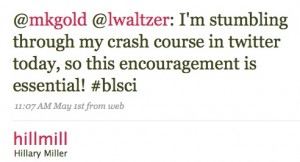Yesterday I attended the Annual Symposium on Communication and Communication-Intensive Instruction at Baruch College, put on by Mikhail and the fine folks at the Bernard L Schwartz Communication Institute. I’ve got a couple of blog posts in the hopper that are inspired by conversations that happened there, but for now here’s a quickie.
Inspired by @hillmill’s tweet, a discussion took place at our lunch table (I think it was me, Suzanne, Matt, and Luke) about how using Twitter as a conference backchannel can turn someone from a casual twitterer to a Serious Twit. Here’s a theory for why that is. The benefit that Twitter backchannels (TBs) can have for conferences has been pretty widely discussed (though, lazy guy that I am, I don’t have any good links right at hand). TBs allow attendees to keep tabs on what’s happening in sessions other than the ones they’re physically attending. They provide a space where people can share immediate feedback on keynotes without all that distracting whispering. TBs also give users a chance to connect to each other in ways that are in a sense more organic than more traditional conference events. I made some connections, for instance, during our morning roundtable discussions, but these were largely accidents of who happened to be at my table – I connected to users of the TB, on the other hand, because of the things they were tweeting about. Even if this isn’t a better way to connect, it’s at least another way, which is surely a good thing. Moreover, TBs allow the conference to benefit people who aren’t in attendance, an effect that is multiplied by retweeting. (If you want some evidence of these effects, check out the #blsci tweet timeline.)
All this is to say that TBs are good for conferences and conference-goers. What makes TBs a good induction into Twitter is the act of witnessing these benefits. When I attended the 2008 CUNY IT Conference last year, I expected it to be like most conferences I’d attended – good in parts, but largely isolating and kind of boring. Given these expectations, experiencing the benefits of that conference’s TB was exhilarating. I knew before going to this conference that Twitter could be a fun performance space, maybe a good place to share links – but seeing it in action as a TB was what really sold me on the technology.
Here’s hoping that #blsci had a similar effect on @hillmill and the other relative Twitter-newbies who experienced the event’s TB.
I’d be interested to hear whether this has happened to others. Have you attended an event where the TB changed the way you think about Twitter?

[twitter] http://tinyurl.com/df3c75 http://tinyurl.com/df3c75
@hillmill here, interesting post, Boone. The symposium experience definitely sold me on some exciting aspects of twitter. You’re right that it can be a fun performance space, and it absolutely spices up the usual conference setting. I got really attached to the ways it enhanced the event with another layer; something to pull focus to particular questions, a way to express responses as they were happening, and to create mini-dialogues within dialogues that could flourish & grow elsewhere.
Those dialogues could also get distracting, though, and I don’t think that the relentless multi-tasking aspect of it would necessarily be right for everyone, or every conference. It also made me aware of that old audience question– were these new #blsci followers the same ones who would care what I happened to be thinking, say, on a Saturday morning after reading the paper? As a new Twit I’m still a little confounded once I get let out of the cozy confines of something like the symposium, where the context & rules of engagement are somewhat more clear.
As it is, I already have too many windows open on my computer at once and I just can’t see getting Twitter on my Treo if it’s gonna translate into paying for more texts. But I already have the sense that I’d be missing out on some great conversations if I abandon Twitter, and I’m curious to see my few lone followers grow into the kind of organic community that I was chatting with Suzanne about today…
The audience question you bring up – whether the #blsci gang is the same one that will care about your weekend shenanigans – is, I think, at the center of the popular fascination and discomfort with Twitter. On one hand, cranky anti-twits complain that they don’t want to hear what so-and-so had for lunch today. On the other hand, proponents see this as part of the “ambient intimacy” that Twitter fosters: seeing the human side of a colleague makes our relationships more real, more civil, more humane, more comfortable, more productive than might have been possible under the traditional formal/non-formal divide. Ultimately, both sides have some truth to them, and there are various positions on the continuum between the total commingling and the complete separation of the public and the private that one might occupy. I think everyone is still trying to figure out where is the right place on this continuum to be, and what criteria we should use to decide the question.
Pingback: Towards the Next Stage of EdTech at CUNY…